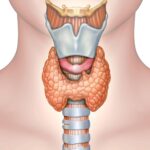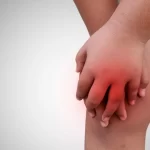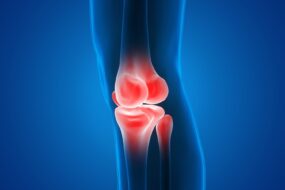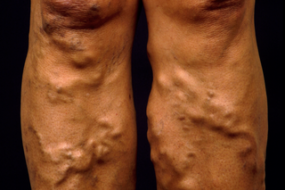
Patients are assessed, and priorities are established based on their injuries, injury mechanisms, and vital signs.
PRIMARY SURVEY
This process constitutes the ABCDEs of trauma care. It identifies immediate life-threatening conditions and is performed in order, beginning with the airway.
It includes;
1. Airway assessment and stabilization of the cervical spine (Ac)
- Airway obstruction can lead to hypoxia and death within a very few minutes.
- In a conscious patient, the evaluation is as follows;
- Begin by asking the patient a simple question such as, “What is your name?”. A clear answer verifies a patent airway
- Observer for signs of respiratory difficulty such as tachypnea, use of accessory muscles of breathing, stridor, and abnormal patterns of breathing
- Do an assessment of the oropharyngeal cavity for any injuries, vomitus, blood, or other secretions. Note any causes of a difficult intubation
- Examine the anterior neck for any bleeding, swelling, lacerations, crepitus, or other signs of injury. Identify the landmarks for tracheostomy in case it will be required
- In the unconscious patient, the airway must be protected immediately once any obstructions have been removed. Perform a pre-intubation assessment. The LEMON criteria are described below;
L– Look for any injuries to the face and neck. This could make it challenging to visualize the glottis or insert an endotracheal tube(ETT)
E– 332 rule
M– Mallampati score
O– obstruction or obesity
N– neck mobility
- Devices for airway management may be used- e.g., oral and nasal airways, endotracheal tube.
Indications for intubation in trauma;
- Comatose patient- GCS less than 8
- Respiratory failure
- Respiratory arrest or apnea
- Severe hypoxemia despite oxygen therapy
- High risk for aspiration, e.g., severe head injury
- Impending airway obstruction
- Burn patients with airway involvement
- Severe shock
- Nonpurposeful motor response
-Cricothyrotomy when intubation fails
Cervical spine immobilization;
– A cervical spine injury should be presumed to be present in all blunt trauma patients unless otherwise proven. The patient’s head and neck should not be hyperextended, hyper flexed, or rotated when establishing the airway. A rigid cervical collar should be put, if not already put, at the site of injury.
– Those with isolated penetrating injury with no blunt injury and an intact neurologic examination typically do not have a spinal injury
– The anterior part of the cervical collar should be removed when doing airway interventions. Tracheal intubation should not be done with the anterior portion of the collar in place
Nexus criteria for C spine clinical clearance;
- GCS 15
- Not intoxicated
- The patient doesn’t have distracting injuries
- Can extend and flex the neck
- Absence of posterior midline and neck pain
2. Breathing and ventilation
- Assess the oxygenation and ventilation using pulse oximetry.
- Inspect the chest wall for signs of injury, asymmetric or paradoxical movement of the chest wall
- In patients with suspected life-threatening conditions such as tension pneumothorax, massive hemothorax, etc., obtain radiographic imaging immediately
- Presumptively, those with signs of a tension pneumothorax, manage with decompressive needle thoracostomy before obtaining imaging
3. Circulation
- Assess for circulatory status using Central and peripheral pulses, capillary refill, and the blood pressure
- Insert two large IV bore cannulas and draw blood for cross-matching and blood typing. Intraosseous access or central venous line can be used if peripheral access is difficult.
- Control external bleeding using manual pressure, tourniquet or manual pressure cuff, and elevation for external arterial hemorrhage
- Direct pressure for venous bleeding
- Pelvic binder for bleeding from a severe pelvic injury
- Emergency thoracotomy for those without femoral or carotid pulses
- Placement of a resuscitative balloon for occlusion of the aorta in those patients in etremis with impending arrest
- Those with hypotension or signs of shock- intravenous fluid resuscitation with a bolus of crystalloid solution. Transfuse with type O blood for those with severe or ongoing blood loss. Use O negative blood in women of childbearing age.
- Those with hemodynamic instability despite IV fluids require blood transfusion and definitive management of the bleeding source. Beware of the five sites of hemorrhage; external, thoracic cavity, abdominal cavity, pelvic cavity, and thighs. Target a ratio of 1:1:1ratio of plasma, platelets, and red cells if transfusion is required. Tranexamic acid can be given within 3 hours of injury.
- Obtain serial blood pressure measurements
- Some patients may require reversal of anticoagulants
- A FAST examination can be obtained at this stage, especially for hemodynamically unstable patients
4. Disability
- Do a focused neurologic evaluation. This includes the GCS, pupillary size and reactivity, motor function, and sensation
- Use of sedatives, alcohol intoxication, severe brain injury, and intubation make the initial GCS score unpredictive of the outcome
5. Exposure and environmental control
- Completely undress the patient
- Examine for any other injuries
- Examine the patient’s back and examine for spinal tenderness
- Prevent hypothermia
Adjuncts to primary survey and resuscitation
They include;
- ECG monitoring- monitor for arrhythmias, pulseless electrical activity
- Vital signs monitoring- using pulse oximetry, blood pressure measurements, ventilatory rate, and arterial blood gases
- X-ray examinations- chest Xray, pelvic Xray, lateral c spine x-ray
- FAST and DPL
- CT scan
- Pregnancy test in females
Laboratory tests;
- CBC, blood electrolytes, urinalysis, prothrombin time, blood glucose, and lactate
Patient transfer;
- Hospitals with limited resources should consult the nearest trauma center as soon as possible. Patients should be well stabilized. The decision should be made by the transferring and receiving physicians in collaboration.
SECONDARY SURVEY
- The secondary survey only starts after completing the primary survey, and resuscitative efforts are ongoing and vital function has normalized.
- Definitive management of a hemodynamically unstable patient must not be delayed to carry out the secondary evaluation.
- A secondary survey is performed on all patients determined to be stable after the primary survey. It includes a head-to-toe assessment. i.e., detailed history, a thorough physical examination, and targeted diagnostic studies
The AMPLE history is a helpful mnemonic to understand the physiologic state of the patient;
A– allergies
M– medications currently used
P– past illnesses/pregnancy
L– last meal
E– events/ environment related to the injury
-The secondary survey plays an important role in avoiding missed injuries
-Common missed injuries;
- Hollow viscus injury
- Diaphragmatic rupture
- Rectal and urethral injuries
- Pancreaticoduodenal injuries
- Esophageal perforation
- Aortic injuries
- Fractures
- Compartment syndrome, etc
Targeted diagnostic studies include;
- Plain x-rays e.g limb x-rays
- CT scan, including whole-body CT
Other measures are taken;
- Analgesia and sedation. Short-acting analgesics are preferred to avoid adverse hemodynamic effects.
- When possible, caretakers should act on the need to preserve evidence if the trauma may be connected to a crime.












